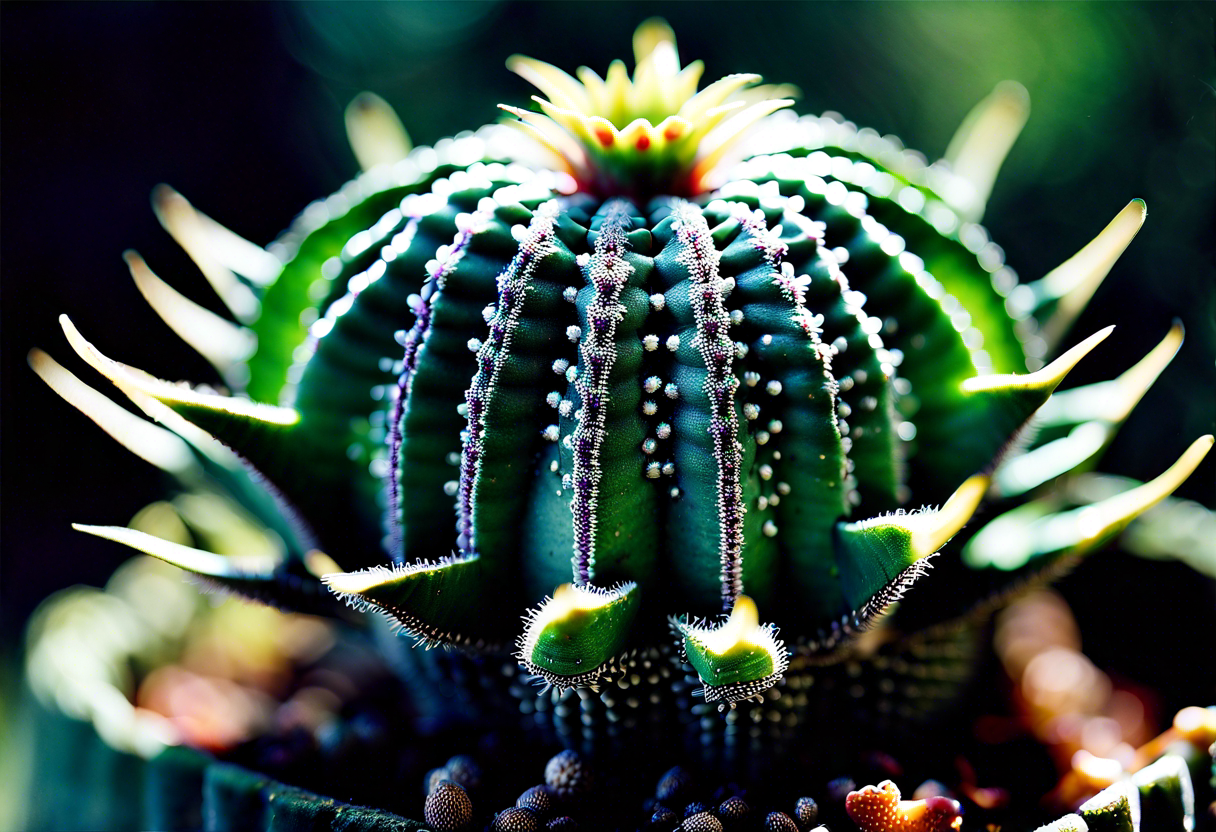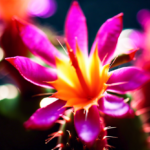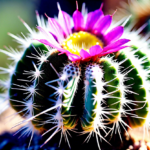Bishop’s Cap (Astrophytum myriostigma): Exploring the Anatomy and Characteristics
When delving into the world of cacti and succulents, the Bishop’s Cap (Astrophytum myriostigma) stands out as a unique and intriguing species known for its distinct appearance and low maintenance requirements. This particular cactus, native to regions of Mexico and Texas, is a favorite among collectors and enthusiasts for its aesthetic appeal and relatively simple care regimen.
One of the most striking features of the Bishop’s Cap is its star-shaped pattern of white flecks, which resemble the pattern on a bishop’s mitre, hence its common name. This distinctive marking sets it apart from other cacti and adds to its allure for plant lovers. Additionally, the Bishop’s Cap has a globular shape with ridged edges, giving it a regal and statuesque appearance that can enhance any indoor or outdoor garden space.
In terms of size, the Astrophytum myriostigma typically reaches a height of around six inches (15 centimeters) and a width of about four inches (10 centimeters) when fully mature. Its slow growth rate makes it ideal for those seeking a long-term plant companion that will not outgrow its designated space too quickly.
As with most cacti, the Bishop’s Cap is drought-tolerant and prefers well-draining soil to prevent root rot. It thrives in bright, indirect light and can even withstand some direct sunlight, making it a versatile choice for various light conditions. When it comes to temperature, this cactus enjoys warm environments and should be protected from frost and extreme cold.
Another fascinating aspect of the Astrophytum myriostigma is its flowering behavior. In late spring to early summer, the Bishop’s Cap produces vibrant yellow blooms that contrast beautifully with its green body. These flowers, though short-lived, add an extra dimension of beauty to an already captivating plant.
The Bishop’s Cap (Astrophytum myriostigma) is a remarkable cactus species known for its distinctive appearance, low maintenance needs, and unique blooming patterns. Whether you are a seasoned plant collector or a beginner enthusiast, this cactus is sure to bring joy and visual interest to your botanical collection.
Best Practices for Caring for Bishop’s Cap Succulents
When it comes to caring for Bishop’s Cap succulents, also known as Astrophytum myriostigma, there are several key practices to ensure they thrive in your care. These unique cacti require specific conditions to flourish and display their distinctive characteristics. By following these best practices, you can enjoy healthy and vibrant Bishop’s Cap succulents in your home or garden.
Light and Temperature:
Bishop’s Cap succulents thrive in bright, indirect sunlight. Placing them near a south-facing window where they can receive sunlight for a few hours a day is ideal. It is important to protect them from intense afternoon sun, especially during the summer months. These cacti prefer warm temperatures between 70-90°F (21-32°C) during the day and slightly cooler temperatures at night.
Watering:
Proper watering is essential for Bishop’s Cap succulents. They prefer infrequent but deep waterings. Allow the soil to dry out completely between waterings to prevent root rot. During the growing season in spring and summer, water sparingly but ensure thorough saturation when watering. In the dormant winter months, reduce watering frequency to mimic their natural growing conditions.
Soil and Potting:
Use a well-draining cactus mix for planting Bishop’s Cap succulents. A mix specifically designed for cacti and succulents will prevent waterlogging and promote healthy root growth. Terracotta pots are excellent choices as they allow the soil to dry out more efficiently. Repotting is typically done every 2-3 years or when the plant outgrows its current container.
Fertilization:
During the growing season, fertilize Bishop’s Cap succulents with a balanced cactus fertilizer diluted to half strength. Apply the fertilizer once a month to provide the necessary nutrients for healthy growth. Avoid fertilizing during the winter months when the plant is dormant.
Pest and Disease Control:
Monitor your Bishop’s Cap succulents regularly for common pests like mealybugs and spider mites. If any pests are detected, treat them promptly with insecticidal soap or neem oil. Additionally, ensure good air circulation around the plants to prevent fungal diseases. Remove any dead or decaying plant material to maintain overall plant health.
By following these best practices for caring for Bishop’s Cap succulents, you can create an optimal environment for these unique cacti to thrive and grace your indoor or outdoor space with their beauty.
For more detailed information on Bishop’s Cap succulents, you can visit British Cactus and Succulent Society.
Understanding the Natural Habitat and Geographic Distribution of Astrophytum myriostigma
Astrophytum myriostigma, commonly known as Bishop’s Cap, is a strikingly beautiful cactus species that is native to Mexico. Its natural habitat consists of arid regions with well-draining soil, rocky terrain, and plenty of sunlight. These conditions make it well-suited for growth in xeriscapes and rock gardens where it can thrive with minimal water and maintenance.
This species can be found growing in the wild in the northeastern regions of Mexico, particularly in the states of Nuevo Leon, Tamaulipas, and San Luis Potosi. The Bishop’s Cap cactus is well adapted to survive in harsh desert environments with high temperatures during the day and cooler nights. Its unique appearance, with its distinctive ribbed texture and star-shaped patterns, makes it a sought-after addition to succulent collections worldwide.
Due to its popularity among collectors, Astrophytum myriostigma is also cultivated in botanical gardens and nurseries globally. Its geographic distribution has expanded beyond its native habitat, with enthusiasts cultivating it in various regions around the world where the climate mimics its natural environment. This cactus species has also been hybridized to create unique varieties that showcase different colors and characteristics, further adding to its appeal among plant enthusiasts.
For more in-depth information on Astrophytum myriostigma and other cactus species, you can visit Cactuslands, a reputable website dedicated to providing valuable insights on cacti cultivation, care, and conservation.
Understanding the natural habitat and geographic distribution of Astrophytum myriostigma is essential for successfully growing and caring for Bishop’s Cap cacti. By replicating its native environment to the best of your ability, you can ensure that your Astrophytum myriostigma thrives and continues to showcase its unique beauty for years to come.
Potential Pests and Diseases that Affect Bishop’s Cap Cacti
Bishop’s Cap cacti, scientifically known as Astrophytum myriostigma, are generally low-maintenance plants, but they are not immune to pests and diseases. It is essential to be aware of the common issues that can affect these unique succulents to ensure they remain healthy and thriving in your garden or home.
One of the most common pests that can trouble Bishop’s Cap cacti is spider mites. These tiny arachnids feed on the plant’s juices, causing wilting leaves and webbing on the cactus. To prevent spider mite infestations, regularly inspect your Astrophytum myriostigma for any signs of these pests. You can use a strong blast of water to dislodge them or treat the cactus with neem oil to deter further infestations.
Another potential pest that can harm Bishop’s Cap cacti is mealybugs. These white, cottony insects feed on the plant sap, leading to stunted growth and yellowing of the cactus. To get rid of mealybugs, gently wipe the affected areas with a cotton swab dipped in rubbing alcohol. You can also introduce natural predators like ladybugs to keep the mealybug population in check.
Apart from pests, Bishop’s Cap cacti are susceptible to diseases like root rot, caused by overwatering or poorly draining soil. To prevent root rot, ensure that your Astrophytum myriostigma is planted in well-draining soil and only water the plant when the top layer of soil is dry to the touch. If you notice signs of root rot such as mushy stems or blackened roots, immediately remove the affected parts and repot the cactus in fresh soil.
Additionally, fungal infections can also affect Bishop’s Cap cacti, especially in humid conditions. Powdery mildew, for instance, can appear as white, powdery spots on the cactus, compromising its overall health. To prevent fungal infections, ensure good air circulation around the plant and avoid overhead watering, which can create a damp environment ideal for fungal growth.
By being vigilant and proactive in addressing potential pests and diseases that can afflict Bishop’s Cap cacti, you can help your Astrophytum myriostigma thrive and remain a stunning addition to your succulent collection. Regularly inspecting your cactus, maintaining proper watering practices, and providing optimal growing conditions are key steps to ensuring the health and longevity of your Bishop’s Cap succulents.
For more information on caring for cacti and succulents, you can visit The Spruce.
Propagating Bishop’s Cap Succulents: Expert Tips for Successful Cultivation
Propagating Bishop’s Cap succulents, scientifically known as Astrophytum myriostigma, is a rewarding process that allows you to expand your collection and share these unique plants with others. While the propagation methods for Bishop’s Cap cacti can be straightforward, there are key strategies to ensure successful cultivation and growth.
One of the most common and easiest ways to propagate Bishop’s Cap succulents is through seeds. These seeds are typically harvested from mature plants and require a well-draining soil mix to germinate successfully. Plant the seeds in a shallow container filled with the appropriate soil, keep the soil consistently moist but not waterlogged, and place the container in a warm, sunny location to encourage germination.
Offshoots, also known as pups, are another method of propagating Bishop’s Cap cacti. Offshoots are small growths that emerge at the base of the parent plant. To propagate using offshoots, carefully remove the offshoot from the parent plant using a sharp, sterile knife. Allow the cut end to callus for a day or two, then plant the offshoot in a well-draining soil mix and follow standard care procedures for adult plants.
Stem cuttings can also be used to propagate Bishop’s Cap succulents, although this method is less common. To propagate using stem cuttings, select a healthy, undamaged stem and allow the cut end to callus for a few days. Plant the cutting in a well-draining soil mix and provide appropriate care until roots develop.
Regardless of the propagation method you choose, it is essential to provide optimal growing conditions for the newly propagated plants. This includes ample sunlight, well-draining soil, and appropriate watering practices. Avoid overwatering newly propagated plants, as they are more susceptible to root rot during this delicate stage.
As the newly propagated Bishop’s Cap succulents grow and mature, continue to monitor their progress and adjust care practices as needed. With patience and attention to detail, you can successfully propagate these unique and striking cacti to enhance your indoor or outdoor garden space.
For more detailed information on propagating succulents like Bishop’s Cap cacti, you can visit The Spruce’s guide to propagating cacti and succulents.
Conclusion
In learning about the Bishop’s Cap (Astrophytum myriostigma), it becomes apparent that this cactus species possesses unique characteristics that set it apart from other succulents. Its distinctive star-shaped markings on its greenish stem make it a favorite among collectors and enthusiasts. Understanding how to care for Bishop’s Cap succulents is crucial for their health and longevity. By following best practices such as providing adequate sunlight, well-draining soil, and proper watering, enthusiasts can ensure that their plants thrive.
The natural habitat and geographic distribution of Astrophytum myriostigma shed light on the origins of this fascinating cactus. Originating from regions in northeastern Mexico and southern Texas, these succulents have adapted to arid environments with high temperatures and low rainfall. Mimicking these conditions in cultivation can help replicate their natural habitat, promoting optimal growth and development.
Despite being relatively low-maintenance plants, Bishop’s Cap cacti are not immune to pests and diseases. Mealybugs, aphids, and spider mites are common pests that can affect these succulents if proper precautions are not taken. Implementing preventive measures such as regular inspections, natural predators, or organic treatments can help keep these pests at bay and maintain the health of Bishop’s Cap plants.
Propagation is an essential aspect of cultivating Bishop’s Cap succulents, whether for expanding your collection or sharing with fellow enthusiasts. Understanding the various methods of propagation, such as seed sowing, offset division, or grafting, can increase your chances of successful reproduction. Providing the right environmental conditions, such as warmth and humidity, is crucial for encouraging the growth of new plants from seeds or offsets.
Bishop’s Cap (Astrophytum myriostigma) is a fascinating cactus species with unique characteristics that make it a sought-after plant in the world of succulent enthusiasts. By learning about its anatomy, caring for its specific needs, understanding its natural habitat, and being aware of potential pests and diseases, individuals can cultivate healthy and thriving Bishop’s Cap succulents. Successful propagation techniques can further enhance one’s enjoyment of these remarkable plants and contribute to the conservation of this iconic cactus species. Taking the time to appreciate and care for Bishop’s Cap cacti allows us to connect with nature and enjoy the beauty and resilience of these remarkable desert plants.


